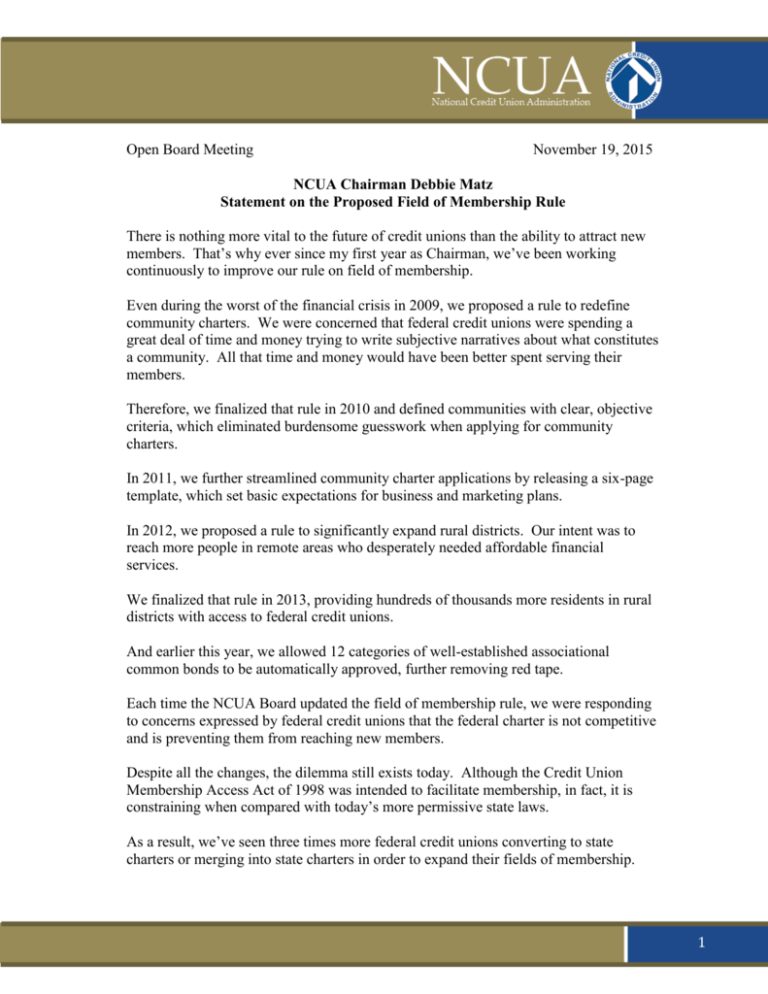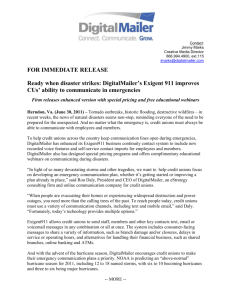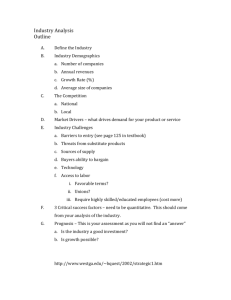file
advertisement

Open Board Meeting November 19, 2015 NCUA Chairman Debbie Matz Statement on the Proposed Field of Membership Rule There is nothing more vital to the future of credit unions than the ability to attract new members. That’s why ever since my first year as Chairman, we’ve been working continuously to improve our rule on field of membership. Even during the worst of the financial crisis in 2009, we proposed a rule to redefine community charters. We were concerned that federal credit unions were spending a great deal of time and money trying to write subjective narratives about what constitutes a community. All that time and money would have been better spent serving their members. Therefore, we finalized that rule in 2010 and defined communities with clear, objective criteria, which eliminated burdensome guesswork when applying for community charters. In 2011, we further streamlined community charter applications by releasing a six-page template, which set basic expectations for business and marketing plans. In 2012, we proposed a rule to significantly expand rural districts. Our intent was to reach more people in remote areas who desperately needed affordable financial services. We finalized that rule in 2013, providing hundreds of thousands more residents in rural districts with access to federal credit unions. And earlier this year, we allowed 12 categories of well-established associational common bonds to be automatically approved, further removing red tape. Each time the NCUA Board updated the field of membership rule, we were responding to concerns expressed by federal credit unions that the federal charter is not competitive and is preventing them from reaching new members. Despite all the changes, the dilemma still exists today. Although the Credit Union Membership Access Act of 1998 was intended to facilitate membership, in fact, it is constraining when compared with today’s more permissive state laws. As a result, we’ve seen three times more federal credit unions converting to state charters or merging into state charters in order to expand their fields of membership. 1 It seems that currently the greatest threat to the dual chartering system is the disparity in fields of membership between federal charters and many state charters. Since viable fields of membership are critical to the future of federal credit unions, it’s clear that the federal charters need a rule that is more permissive than any rule we’ve approved in the past, yet stays within our statutory authority. So, we are proposing today the most comprehensive field-of-membership reform in the history of NCUA. As we began to contemplate this rule, my charge to the staff was to: Mitigate competitive disparities between federal and state charters on field-ofmembership issues; Include any stakeholders who care to participate and solicit their best ideas; Think far outside the box; but Always be mindful of the statutory limits and stay well within them. I’d like to express my sincere gratitude to everyone who consulted with the Field of Membership Working Group, which I created in December of 2014. Over the past year, the Field of Membership Working Group staff spoke with hundreds of stakeholders from every region of the country. They heard from credit unions with federal and state charters, as well as their trade associations. They heard from credit unions of all sizes—urban and rural, single-sponsor and multiple-group. And they heard from low-income credit unions and credit unions serving underserved areas. In the end, they heard from every stakeholder who asked to participate, and the participants provided thoughtful input on every aspect of membership eligibility. As staff reported to me on their progress, I was thoroughly impressed with the caliber of the Working Group’s dialog and the carefully considered, wide-ranging suggestions. Now, I know there are those who thought I should have created an Advisory Committee instead. However, the Working Group structure was far more flexible and inclusive than a formal Advisory Committee would have been. The Working Group was able to consult with all interested stakeholders, rather than just a static Advisory Committee with as few as 10 members. The Working Group was able to begin gathering input from stakeholders immediately, rather than waiting for each member of an Advisory Committee to be vetted and approved by the Office of Management and Budget. The Working Group was also able to gather input more frequently. The group held conference calls nearly every week, instead of trying to schedule quarterly in-person meetings with an Advisory Committee. In fact, if we had gone the Advisory Committee route, we’d probably still be a year away from proposing this rule. 2 In addition, the Working Group completed the project more cost-effectively. Rather than paying travel expenses, which would have been required by law for an Advisory Committee, the Working Group did not add any expenses to the NCUA budget. In fact, the Working Group gathered input from stakeholders more inclusively, more quickly, more frequently and more cost-effectively than an Advisory Committee. As a result of the extensive public input we received from a wide range of stakeholders, this proposal includes creative ideas that would provide real regulatory relief to a wide range of credit unions. In addition—and perhaps more importantly—it would permit many federal credit unions to serve more potential members. Our over-arching vision is to enable federal credit unions to reach potential members from all walks of life: from rural towns to inner cities and from low-income communities to underserved areas. Whether they work on family farms, in industrial parks or office buildings, are full-time employees or hourly contractors, or if they are currently serving our country or are honorably discharged veterans—there are millions of potential members who want and need affordable financial services. They should be able to choose a credit union rather than turn to predatory lenders. And as long as it’s legally permissible to do so, federal credit unions should no longer have to turn them away. Our Office of Consumer Protection will continue to ensure that federal credit unions have the ability and commitment to serve their entire field of membership—including diverse demographics and low-income residents. While this proposed rule would remove some disparity between federal and state charters, it would also benefit many state charters. In states with “wild card” or “parity” provisions, state charters would be authorized to add new provisions granted to federal credit unions. We even received support from several state regulators as we developed this proposal. Although we’ve already received unprecedented input going into this proposed rule, we look forward to even more input during the comment period. I’m especially interested in comments about how we could further streamline both the application and approval processes behind field-of-membership changes. Last month this Board took the first step by removing ourselves from the process of approving community charters with populations over 1 million. This removed up to two months from the approval timetable. Our Office of Consumer Protection is working to streamline many processes for smaller additions, such as adding new select employee groups of just a few thousand employees more efficiently. 3 We’re seeking comments on exactly what that number should be. Our intent is to significantly reduce the amount of paperwork it takes federal credit unions to add new members. This in turn will substantially reduce the turnaround time before federal credit unions can begin serving those new members. By improving the application process, we will save federal credit unions—and NCUA—time and money. All in all, this proposed rule is consistent with my Regulatory Modernization Initiative and President Obama’s Executive Order 13579. This proposal represents a modernized approach to meet the needs of federal credit unions, small businesses, and consumers, while complying with all statutory requirements. Most importantly, it would expand consumer choice in the marketplace and increase access to affordable financial services. 4









